The Hertsrail project proposes improvements to the rail network, with a primary focus on Hertfordshire.
Later on this page is our specific proposal "Light rail from London Colney to Watford".

London Colney has no railway station.
An online map showing London Colney is available here London Colney and area (opens in new window or tab) Source : openstreetmap.org © OpenStreetMap contributors
We propose London Colney as an M25 parkway station. The station would be located at M25 junction 22.
Drawings (diagrammatic maps) are displayed full size for clarity.

There would be a Thameslink service from London Colney connecting on to the Midland Main Line (MML), which is the line via St Albans City and Radlett. A primary aim would be to provide improved access to St Pancras International for continental rail services for those commencing their journey by car. The service from London Colney would call at St Pancras International, central London stations and Gatwick Airport.
During the weekday morning peak, the train service would offer the same calling pattern as other Thameslink services i.e. the stops as above and additional stops. It is anticipated that during the morning peak there would be priority access for Hertfordshire residents, also for those with pre-booked tickets for continental rail travel. Outside of the morning peak, the station provides a convenient means for rail access to central London for anyone commencing their journey by car.
We do not know whether there would be a check-in facility for continental rail travel at London Colney. Also we do not know whether continental rail services themselves would be extended to London Colney.
The Crossrail 2 project, which would have provided improved access to St Pancras, although not for those commencing their journey by car, has been paused. Realistically it has probably been cancelled. A station at London Colney provides some compensation for this.
Britain's railways are expensive. It seems likely that steps will be taken to reduce rail costs and, whilst we would not wish this, it is likely that this will at some stage result in a reduction of the rail network. In the case of reduction of the rail network, it is likely that London Colney would take on an increased role, access to London by means of journeys to some existing stations being replaced by journeys to London Colney.
Motorail means putting your car on the back of the train. Although there is a short shuttle service through the Channel tunnel for cars, there is no motorail service to continental Europe. It is possible that London Colney would be a suitable location.
There is a plan to convert the St Albans Abbey branch into a busway, documented by Hertfordshire County Council in March 2024. This takes no account of the potential for this branch line to support the regional economy as part of a joined-up rail network.

Further information : Connecting the Abbey line to Watford High Street (opens in new window or tab). We hope it will prove worthwhile to read through to the end of the article.
There are multiple possibilities. One possibility is light rail London Colney to St Albans Abbey and intermediate stations to Watford Junction, Watford High Street, terminating at Watford's hospital. A second possibility is an extension of the London Overground (Lioness) line to St Albans Abbey with a Thameslink service from St Albans Abbey. A third possibility is an extension of the London Overground (Lioness) line to London Colney or an extension to Luton Airport Parkway, in either case changing direction at St Albans Abbey. There could be a Thameslink service changing direction at St Albans Abbey, terminating at London Colney: this would be an interim arrangement, subsequently replaced by Thameslink via the East Coast Main Line (ECML) to London Colney, illustrated in aspiration 3 below, continuing via St Albans City. With either the Croxley rail link or Ebury Way rail link, illustrated above, there is the possibility of an Oxford to Cambridge service via Watford Junction. Later on this page is our specific proposal "Light rail from London Colney to Watford".
There is the potential to extend the Hertford East branch line to provide a service via Watton at Stone and Stevenage. This was illustrated as part of aspiration 1 above and is also illustrated below.
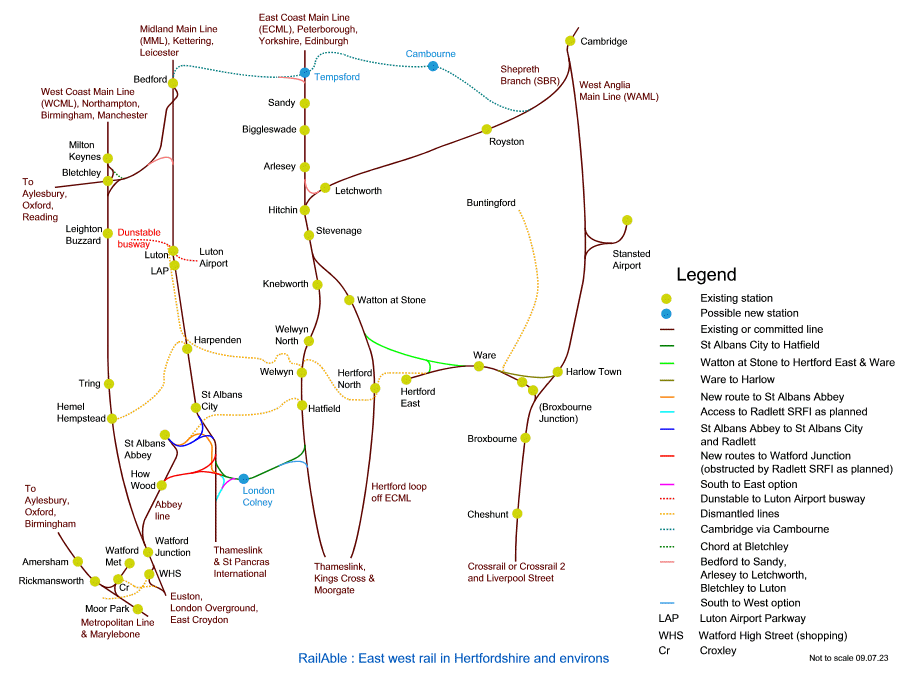
It should be borne in mind that our diagrammatic maps are intended to illustrate railway infrastructure and are not to scale.
The East Coast Main Line (ECML) has four tracks from Stoke tunnel, south of Grantham, to London Kings Cross, except between Peterborough and Huntingdon and between Knebworth and Welwyn Garden City. There are only two tracks between Knebworth and Welwyn Garden City including two tunnels in succession, Welwyn North tunnel and Welwyn South tunnel and then Digswell viaduct. This bottleneck might be expected to be working at capacity but for the fact that Welwyn North station is located on the bottleneck.
This bottleneck has been the subject of discussion for many years and with no obvious resolution. If the service currently terminating at Hertford East were to be extended to provide a service via Stevenage, it would enable capacity release on the ECML two track section between Knebworth and Welwyn, in other words, take pressure off this two track section by diverting some ECML trains via the West Anglia Main Line (WAML).
We hypothesise two alternatives for extending the Hertford East service. The first is a service from Peterborough terminating at Liverpool Street. The second is a service from Oxford via Bletchley, Bedford and Stevenage terminating at Liverpool Street. Either of these would take pressure off the ECML bottleneck, the second having the advantage of providing Oxford with an ECML interchange at Stevenage for Lumo services.
We note an alternative possibility. By connecting Crossrail (Elizabeth line) on to the line to Tottenham Hale, possibly by means of a new line crossing the Olympic Park, we have the option of a Crossrail (Elizabeth line) circular service. The route is Paddington, Liverpool Street, Tottenham Hale, Cheshunt, Ware, Stevenage, Bedford, Bletchley, Oxford, Didcot Parkway, Reading, Paddington.
Taking pressure off the bottleneck enables more services to run on the ECML. However one of the problems faced by the railways is that an increase in passenger numbers does not result in a reduction in the subsidy paid by the taxpayer. A limited number of additional passengers off-peak will make use of empty seats but generally speaking an increase in passengers implies more trains and more staff and which is not paid for by the additional revenue. Because the costs are so high, it would be reasonable to describe Britain's railways as an unsustainable mess. We understand travel by train to offer advantages but we are certainly not train enthusiasts : railways need to be based on commercial reality. Everything is expensive including the capital costs of capacity enhancements.
In these circumstances it would not be unreasonable to prevent costs rising unnecessarily by means of a blanket refusal to fund capacity enhancements for passenger services. We would not wish to dispute the wisdom of any such approach. If there is no room on the train, people have to find another means of travel or change job, although this does limit growth of the economy. Additionally, Britain's population is increasing, which indicates we need to reduce car-centric travel including for reasons of road congestion and of demands on space. It seems to us that new roads including parking demand more space than the new houses that accompany them. This is unsustainable as the population increases. We are faced with a conundrum. Railways are unsustainable and the same is true of car-centric travel, albeit for different reasons.
In passing, we are not bus enthusiasts. Travel by bus is unpopular and marketing initiatives will not resolve the reasons for that.
Given this conundrum, we respectfully suggest there may be motivation to find a means to radically reduce the cost of railways. Whilst it may be politically unpopular to highlight this, in Victorian times railways were technology-leading and cost-effective to the taxpayer, shareholders taking the risk.
Let us assume that, at some point in the future, railways become cost-effective, or at least more so. It would be prudent to plan ahead for such a scenario. We then face a further issue. As the population increases and house building is improvised, planning of new railway lines that serve centres of population becomes increasingly difficult. Moreover, as recent experience with High Speed 2 has demonstrated, the decision to build new lines is emotionally charged and liable to swing in an opposing direction at any moment.
We do have a proposed strategic solution to this combination of less than ideal set of constraints. The proposed solution is to plan ahead, specifically, to separate the calm and hopefully level-headed process of planning lines and safeguarding them from the politically-charged decisions as to whether or not to build any specific line. This would be particularly useful if we were to transition to at least some private railway lines, planning being a much lengthier process than it would have been in Victorian times. We might envisage private railway companies choosing, on the basis of commercial acumen, whether or not to construct and operate a line the planning of which was by a public authority. This is not PFI (Private Finance Initiative), a private company making the decision and taking the risk.
We hope to have made the point. Railways are too expensive but the situation might improve. Specifically, we do not propose that an extension of the Herford East branch should be built. We do however propose that a decision should be made to plan such an extension and safeguard the route.
The plan for an Oxford to Cambridge service, illustrated above, is via Bicester, Bletchley, Bedford, Tempsford and Cambourne. Published research has demonstrated the need for better town-to-town and town-to-city connectivity across the region, also that the market is understood to be limited for direct travel between the cities of Oxford and Cambridge.
There has been discussion of a railway line between Luton and Stevenage but which would suffer from multiple unresolved issues. Trains would be unable to use the line without requiring paths (space/time slots) on the Midland Main Line (MML) and ECML. The former Dunstable to Leighton Buzzard and Dunstable to Luton lines are no longer open: the latter having been converted into a busway effectively kills off any realistic prospect of a Luton to Stevenage line. Although included in Hertfordshire's rail strategy, we are concerned that its inclusion there has been designed to conceal the significance of the proposal to convert the St Albans Abbey branch, although in active use, into a busway i.e. as documented by Hertfordshire County Council in March 2024.
It seems to us that any option for an Oxford to Cambridge service better serving centres of population would be via London Colney. As a result, we propose that a connection eastwards from London Colney to the ECML northwards towards Hatfield, possibly also southwards towards London, should be planned and safeguarded. The result is a St Albans to Hatfield line.
Conversion of the St Albans Abbey branch into a busway would render improbable a St Albans to Hatfield line and we would then lose any possibility of Oxford to Cambridge via centres of population. This could be described as undermining the future prosperity of the Oxford to Cambridge regional economy. Given that this regional economy is pivotal to the government's ambition for the UK to be the world's next Silicon Valley ( https://www.englandseconomicheartland.com/about/our-region/ ), we would be taking a dramatic step and with no prior evaluation, also known as a planning disaster.
Further information : Impact on the Alban Way (opens in new window or tab). We hope it will prove worthwhile to read through to the end of the article.
An Oxford to Cambridge service via centres of population could be via Bletchley, Luton, London Colney, Stevenage and Letchworth or via Aylesbury, Watford Junction, London Colney, Stevenage and Letchworth. Assuming there is a direct service between Oxford and Cambridge via Bletchley and Bedford, the second of these two overlaps less. There is already a service to Cambridge via Stevenage and Letchworth. With an additional platform 0 at Stevenage, trains could change direction there to connect Knebworth and Watton at Stone. By also making use of a connecting chord from Ware to Harlow Town, we have a route that enables substantial town-to-town connectivity with minimised overlap with any existing service. This route probably provides good value for money in terms of boosting the regional economy. A number of infrastructure interventions would be needed and so this is a longer-term aspiration. The route is Oxford, Bicester, Aylesbury, Wendover, Great Missenden, Amersham, Rickmansworth, Watford Junction, St Albans Abbey (change of direction), London Colney, Hatfield, Welwyn Garden City, Knebworth, Stevenage (change of direction), Watton at Stone, Ware, Harlow Town and Cambridge. A variation of this would be via Bletchley, Luton and St Albans City.
This service requires paths (space/time slots) on the ECML bottleneck at Welwyn however this is offset as described under aspiration 3 by means of capacity release i.e. services from stations on the ECML via the WAML to Liverpool Street.
A possible interim service prior to the implementation of aspiration 4 would be an extension of the London Overground (Lioness) service currently terminating at Watford Junction. The service would run via St Albans Abbey (change of direction), London Colney, Hatfield, Welwyn Garden City, Stevenage (change of direction), Ware and Broxbourne to Liverpool Street.
Hertfordshire County Council's plans include a South Hertfordshire east west road-based Mass Rapid Transit (MRT) project centred on the A414. Formerly known as the A414 Mass Rapid Transit (MRT) project, also known as the South Hertfordshire MRT project, it is now known as HERT, Hertfordshire - Essex Rapid Transit.

Hertfordshire - Essex Rapid Transit (HERT) is a collection of bus services. A comparison with the rail network illustrated earlier shows that it takes no account of the existence of the Watford to St Albans branch railway, nor of the Hertford East branch. The bus services compete with the train services on these branches.
HERT assumes that railways are too expensive. Whilst we agree railways certainly are expensive, we would question the assumption that the situation cannot improve, as outlined earlier. HERT seems to be a straitjacket designed to close branch railway lines. Since railway lines are the responsibility of central government, this suggests that HERT is a government proposal presented by Hertfordshire County Council. Thus, for example, when the county council submits a business plan to the government, what actually happens is that those who are proposing HERT take the opportunity to mark their own homework. This could also suggest county councillors are being guided rather than deciding what is best for Hertfordshire. Worse still, Westminster MPs may feel they cannot involve themselves in a county council proposal, when it is in fact a government project. Noteworthy in this respect is the support for HERT from regional transport body England's Economic Heartland although no reasons are supplied.
Regional transport body England's Economic Heartland formerly commissioned professional-quality research. Indeed it is this past research and also that of the East West Rail Consortium, now named the East West Main Line Partnership, that we have analysed resulting in our published aspirations. It is a shame that England's Economic Heartland has been transformed from a rational organisation providing professional-quality research to promote HERT and without explanation. This transformation is the opposite of what many industry commentators would be hoping for as a response to the Williams Shapps Plan for Rail.
Our published aspirations are the results of some years of research. This is our list of documents (opens in new window or tab). Bearing in mind that the HERT project has changed name several times, there are documents that assume the project and documents that discuss alternatives for the project, for example the routing of buses through Watford town centre, however there is no document that justifies HERT. Anyone who disagrees is invited to find a document justifying HERT either from our list of documents or elsewhere. The promotion of HERT with no document justifying it might reasonably be described as propaganda.
We have yet to publish a response to documents published by England's Economic Heartland in September 2024 although this will not result in any change to our proposals and is unlikely to result in any change to our comments on this webpage.
Railways are a central government responsibility and centrally funded. The closure of lines to be replaced by bus services treats the residents of Hertfordshire as second class citizens. HERT does not seem to be any more than a marketing exercise designed to persuade the people of Hertfordshire to vote against their own best interests.
The A414 corridor strategy technical report included in the list of documents above, page 207, indicates that "A heavy rail route would also potentially work against a MRT system through Hertford". This is indeed what we are proposing as aspiration 3.
HERT is a collection of bus services. However, as illustrated below, the primary focus is on Watford to Harlow, also Hemel Hempstead to Harlow. HERT documentation describes these as high-frequency bus services.
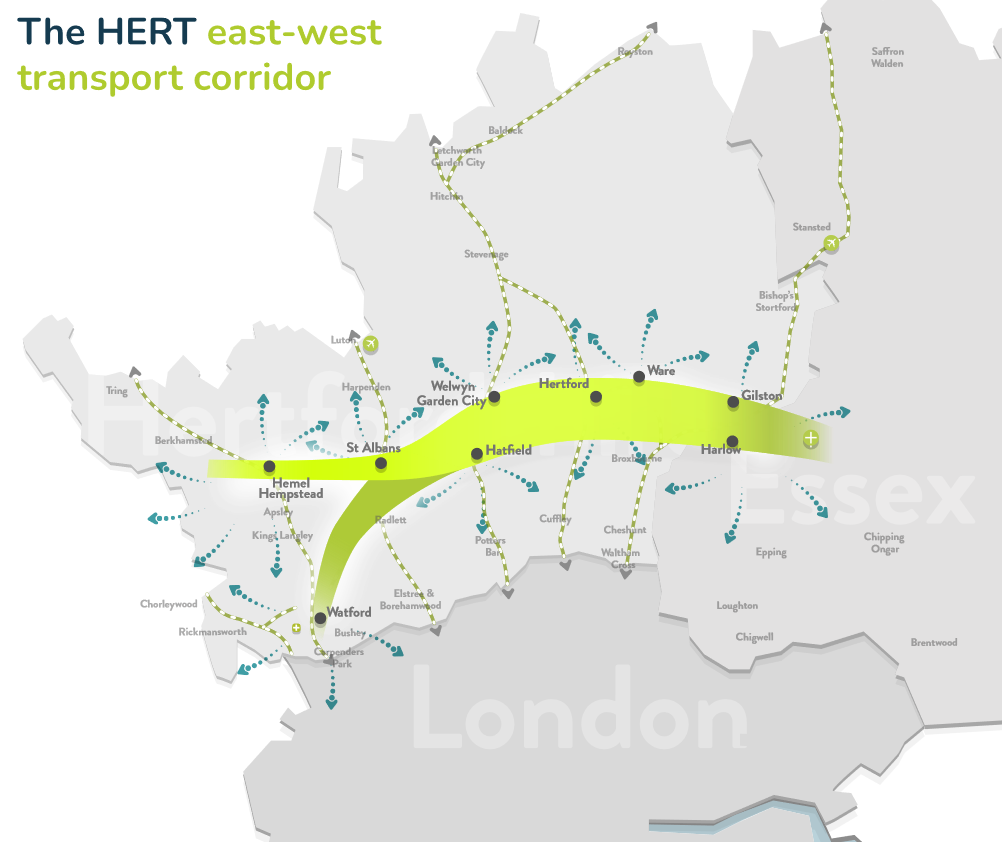
Website intalink.org.uk is the reference for existing bus services. Currently bus travel between Hemel Hempstead and Harlow requires a change of bus, typically the 302 and then the 724 Green Line. We have no objection to a direct bus service as part of HERT although the fact that there is no such service currently could suggest passenger uptake could be poor. HERT envisages separation of lanes on the A414, one being for HERT buses and driverless cars, the other for all other traffic. This presumably could result in a reduction of journey time for buses. This matter is being researched. We do not know how the separation would occur.
The second high-frequency bus service is between Watford and Harlow. Green Line 724 provides this as a direct service via the A405 and A414. We know this service has been running since the 1970's ( https://en.wikipedia.org/wiki/Green_Line_bus_route_724 ) and is therefore a success. It runs from Heathrow Airport to Harlow, via Watford, St Albans, Hatfield, Welwyn Garden City, Hertford & Ware. Watford to St Albans is a very short leg of this route. Converting the Watford to St Albans branch railway to a busway to accommodate it would make very little difference and therefore does not justify conversion of the railway.
Let us turn our attention to more local bus services. HERT includes a service from Watford Junction to St Albans City for Thameslink. We regard this as misguided. Most passengers making use of Thameslink will be travelling to London, not to Bedford. A strategically useful bus link from Watford would be to Radlett and not to St Albans City. Watford to Radlett is provided by bus 602 but which would benefit from some upgrades to include an express service. Additionally bus service 602 fails to serve Watford Junction.
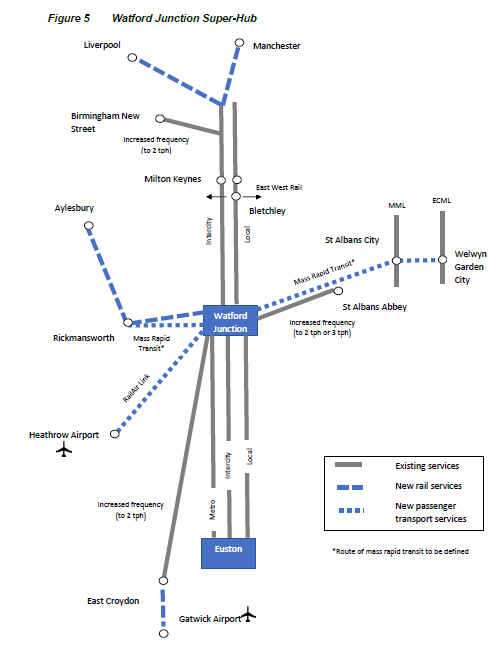
For local travel from Watford to St Albans, there is bus 321 or 724 or 725. As for the 724, bus 321 has also been running since at least the 1970's and is therefore a success. There is also the railway line with several options for walking to St Albans city centre e.g. via Verulamium Park and a very pleasant walk it is. The 321 bus has local stops and the railway line has five intermediate stations. Converting the Watford to St Albans railway to a busway with the 321 using it would result in the loss of the existing route i.e. along the A405 and therefore offers solely a reduction in service.
If the St Albans Abbey branch is converted to a busway, bus services will be invented to use it, as an exercise in making the facts fit. However an analysis of buses provides no good reason to convert the St Albans Abbey branch line into a busway.
Mass Rapid Transit (MRT) i.e. buses is illustrated above running from Rickmansworth to Welwyn Garden City. This journey is available currently by 724 or by 725. The latest documentation, March 2024, suggests that the MRT bus service will run from Croxley rather than Rickmansworth.
Conversion of the Abbey line to a busway requires buses to take over the underpass at Watford Junction from Station Road to the car parks, rendering the car parks inaccessible and therefore triggering redevelopment of the station.
The finances of HERT are unclear but it seems HERT is partly funded by capitalising on the commercial value of land at Watford Junction. If Watford Junction can be redeveloped to enable buses to make use of the underpass, then it can be redeveloped for a new rail connection making use of the underpass i.e. connecting the low-numbered platforms to the Abbey line.
Comments regarding redevelopment of Watford Junction need to be understood in the context of closure of the Abbey line as a railway. Keith Williams included in the Williams Shapps Plan for Rail on page 43 the plan to redevelop Watford Junction : "The masterplan at Watford Junction includes better walking routes and a new bus station, easier navigation, new offices and 3,000 new homes." Was the author buying into the plan to close the Abbey line or was he not informed of the reason for the redevelopment?
It is sad to note that redevelopment of the station is presented as an opportunity to capitalise on the commercial value of the site, the real reason being to enable buses to cross the main line. The true costs of HERT are therefore being disguised. If redevelopment of the station can fund a bus proposal then it can fund improved rail connectivity, particularly since this would facilitate future prosperity of the regional economy, as noted earlier under aspiration 4, rather than undermine it. This provides an important reason to oppose both the conversion of the Abbey line to a busway and the currently-planned redevelopment of Watford Junction.
It is not unknown for housing estates to be directly connected by links only available for buses, coaches and possibly also cyclists. This link is for buses and cyclists:
Buses cross a main road by means of traffic lights whereas there is an underpass for cyclists, on the right hand side, in this photo:
HERT is a straitjacket for bus services, constrained to make use of the A414. There does not seem to be any good reason for this. It is not desirable for passengers to have to wait at bus stops alongside the A414. Bus links enable congestion-free routes for bus services from housing estates to town centres and work areas. In comparison, although the marketing has been extensive and glossy, we are unaware of anyone who has been able to provide a rational explanation for HERT in its current form.
Whilst we have no objection to bus services making use of the A414 we certainly object, as stated above, both the conversion of the Abbey line to a busway and the currently-planned redevelopment of Watford Junction.
HERT envisages separation of traffic on the A414 so that buses are not impacted by congestion. The method of achieving this is being researched. Radlett freight terminal served by a stream of lorries adds to the traffic. The result of these two plans combined seems to be to render inevitable an upgrade to the A414 to become a super-highway. The value for money of these two plans which together result in a major road upgrade, the funding for which has not been included in the plans, needs to be assessed. The residents of Hertford have objected to plans for a bypass. To avoid underhand tactics, the complete plans for upgrading the A414 need to be published.
The Abbey line has potential as part of a joined-up rail network benefiting the residents of Hertfordshire, this being the Hertsrail proposals and forms the alternative to upgrading the A414. The plan to close the Abbey line has far-reaching implications since it would then not be possible to propose a joined-up rail network as an alternative to upgrading the A414. The Hertsrail proposals need to be progressed.

Mark E Townend has put forward a proposal for east west light rail at Watford passing beneath the Stephenson Way Viaduct i.e. running beside the A4008 Stephenson Way. This would connect the Abbey line to Watford High Street : east west light rail at Watford (opens in new window or tab). A possible outcome might be a light rail link from London Colney via St Albans Abbey, Watford Junction and Watford High Street to Watford's hospital. From London Colney the link could run parallel to the Midland Main Line (MML) passing beneath the A414. The A414 bridge over the MML features spare capacity for an extra track on the western side, illustrated in this Google street view northwards from North Cottages : Northwards view of A414 bridge (opens in new window or tab).
In this youtube video it is possible to see through the left-hand section of the bridge at time 15:15 to 15:16
https://www.youtube.com/watch?v=77ZXgaCmmqY
The annotation Napsbury (1905 - 1959) added to the video would refer to the former railway station. It does not refer to the bridge.
The view of the left-hand section is probably obscured by foliage in summertime. The next bridge in the video is the Napsbury Lane bridge.
Views from the A414 bridge southwards view southwards second view southwards Views from the A414 bridge northwards looking towards the Napsbury Lane bridge view northwards second view northwards third view northwards fourth view northwards (open in new window or tab). Although earthworks would be necessary an additional track is feasible.
Views southwards from the Napsbury Lane bridge of the A414 bridge view second view (open in new window or tab). It is hoped that the new track would run parallel to Napsbury Lane on the western side, illustrated in orange later on this page, the Napsbury Lane bridge over the MML remaining unchanged. Thus neither the A414 bridge nor the Napsbury Lane bridge has to be rebuilt.
On approach to St Albans Abbey the rail link would pass beneath Cottonmill Lane. This is the alignment of the former Hatfield and St Albans Branch. A book with this title was published by Oakwood Press now incorporated into Stenlake. The book is out of print. We purchased a copy second hand for £ 14.25 plus postage. The book includes a photo which we have included here, showing the line from Hatfield to the Abbey station passing beneath Cottonmill Lane. The Watford Junction to St Albans Abbey line is this side of the gasworks but cannot be seen in the photo. The photo is reproduced with the intention of reopening this section of the former railway line i.e. to become London Colney to St Albans Abbey.
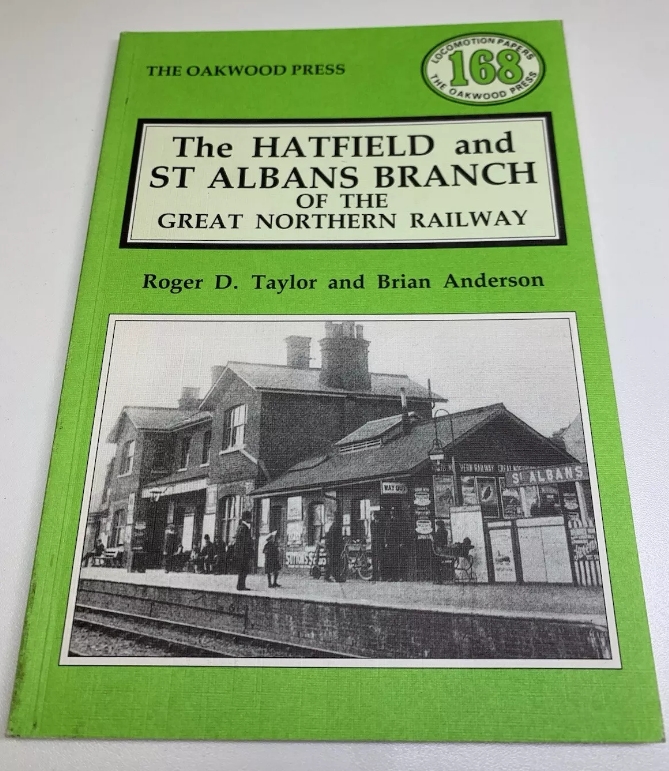
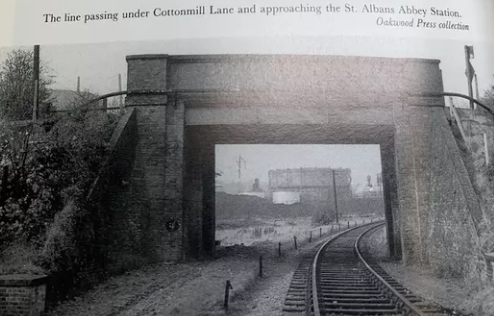
There are photos of the former railway line at smallford.org including a photo showing the former line to Hatfield on the left and the current line to Watford on the right. The photo also shows the Cottonmill Lane bridge on the line to Hatfield. The Abbey station is behind the photographer. Our proposal is that a train or light rail vehicle from London Colney would change direction at the station and continue to Watford : Watford and Hatfield lines (photo opens in a new window or tab).
The former Hatfield to St Albans branch is now the Alban Way, much appreciated for walking and cycling: online map (all links open in a new window or tab) Source : openstreetmap.org © OpenStreetMap contributors. In this photo (photos courtesy of Google) the Alban Way passes beneath the Cottonmill Lane bridge. Alban Way passing beneath Cottonmill Lane The Alban Way would be relocated at this point and there would no longer be public access to pass beneath this bridge. It remains feasible to connect from here onto the Abbey line. This was the view westwards from Cottonmill Lane with premises used by the Scouts on the northern side of the required link i.e. on the right hand side in this photo. The Abbey line is not visible because of foliage. Former view Cottonmill Lane westwards Subsequently the premises used by the Scouts were redeveloped to become Jenny Lane but which did not encroach onto the site required for connecting onto the Abbey line. Subsequent view Cottonmill Lane westwards Again the Abbey line is not visible because of foliage.
Hertfordshire County Council's A414 corridor strategy technical report in 2018 refers to the possibility of a new bridge over the Abbey line for pedestrians and cyclists. Bridge over Abbey line replacing the Cottonmill Lane foot crossing (opens in new window or tab). We suggest this new bridge and relocation of the Alban Way in the vicinity as outlined above could reasonably be planned as a single project.
At Watford, the proposal by Mark E Townend for a track passing beneath the Stephenson Way Viaduct is specifically for light rail since the curvature and gradient are thought to be unsuitable for conventional rail. Following implementation of a light rail link, it would make sense for any redevelopment of Watford Junction to permit connection of the Abbey line to the low-numbered platforms, illustrated below. Conventional rail would operate on the Abbey line, either replacing light rail or sharing track with light rail.

Source : openstreetmap.org © OpenStreetMap contributors
It is unlikely light rail would operate on the MML. Because of the possibility of conventional rail subsequent to light rail, it would be appropriate to plan and safeguard a connection between St Albans Abbey and St Albans City. The track would basically form a semi-circle, trains changing direction at St Albans Abbey and illustrated in dark blue below.

To magnify for consideration of details we suggest image suitable for magnification (opens in new window or tab).
This illustrates co-existence with Radlett freight terminal This is based on an original courtesy of SEGRO. At the time of writing this is at segro.com/media/lw4iroh0/jcg25952-radlett-srfi-plan.jpg
As from July 2024, our specific proposal is light rail from London Colney to Watford. This would dovetail in with our aspirations listed at the top of this page.
Further information is available by following two links provided earlier and by reading to the end of each article. For example, the plan to convert the St Albans Abbey branch
into a busway, documented by Hertfordshire County Council in March 2024, is to be found in part four section "HERT converts the Abbey line to a busway".
Information on Radlett Strategic Rail Freight Interchange (SRFI) is to be found in part four (earlier) section "Options for east west rail at Watford Junction".
Here are the two links:
Part four of our research : Connecting the Abbey line to Watford High Street
(opens in new window or tab).
Part three of our research : Impact on the Alban Way
(opens in new window or tab).
To support our proposals for a joined-up rail network in Hertfordshire, we invite you to read our previous newsletters and sign up to receive them at Hertsrail newsletter (opens in new window or tab).
AbbeyRail, the St Albans Abbey line passengers' association, AbbeyRail (opens in new window or tab) aims to secure the future of the Abbey line.
Britain's railways are expensive. Although dated, facts are available at https://www.gov.uk/government/speeches/george-bradshaw-address-2023
With cross-party political consensus, it seems to us that the cost of railways could be reduced substantially. To explain this, firstly a brief review. In the days of British Rail, the focus was on cost management. This was successful but with a lack of customer focus, to put it mildly. Franchising aimed specifically to address this and, although masked by increased customer expectations over this period, did indeed produce a focus on the customer, albeit with a lack of focus on cost.
This extremely brief summarised review provides us with hope for the future. Specifically, both the target in the days of British Rail and the target in the days of franchising were essentially met. What if a target were to be set to address both the matter of cost and the matter of customer focus? Our suggestion is straightforward. By transferring hands-off responsibility for the railways to Great British Railways (GBR) with the expectation of professional-quality leadership and with a target to reduce costs per passenger mile, GBR is then charged to make an assessment as to how this can be achieved. There is indeed here a focus on cost, however a lack of focus on the customer would result in failure to meet the target. The focus is on both cost and customer. The means to make progress is then for all operations to be professionalised. To the best of our knowledge, we are the first to make this proposal.
To meet a target of reducing costs per passenger mile, unfortunate aspects of what is to be found today, as documented in the Williams Shapps Plan for Rail, would have to be ironed out. Whether adversarial relationships, a cannot-do attitude or over-specification, management will be needed to address such issues. It is also possible that GBR would be able to suggest changes in legislation to facilitate achievement of its target, in place of a handed-down and sometimes ideologically-driven legislative framework.
We estimate that costs can be reduced, with railways satisfying a greater proportion of the travel market, by means of hands-off professional-quality leadership given a target to reduce costs per passenger mile. However this would require a cross-party political consensus.
The plan to close the St Albans Abbey branch demonstrates an inability to assess the commercial potential of this line as part of a joined-up rail network. A lack of commercial acumen represents a lack of focus on the national or, in this case, regional interest. Many industry commentators would interpret the Williams Shapps Plan for Rail as a call for professional-quality oversight. If this were to be realised, it is likely the plan to close the St Albans Abbey branch would be abandoned.
We conclude our home page with a view of St Albans Abbey station on a sunny day in 2017. The links at the top of the page are for further information.
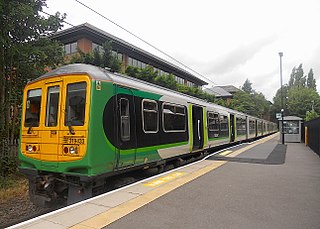
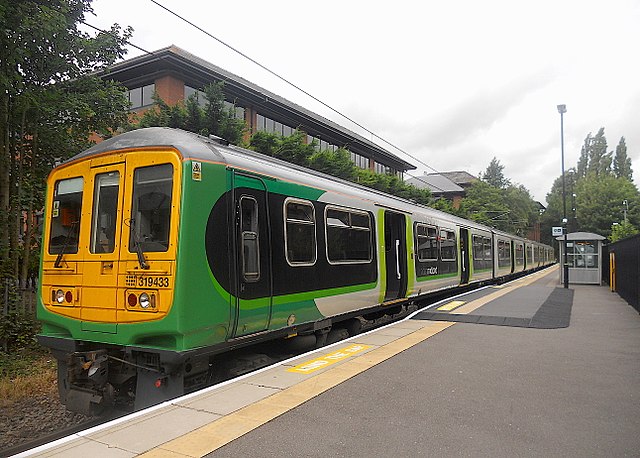
St Albans Abbey station on a sunny day in 2017. PeterSkuce, CC BY-SA 4.0, via Wikimedia Commons.
We do not use cookies nor do we process personal data such as IP addresses. There are no ads on this website, although there are references to our own rail proposals.
Last revised 06 October 2025